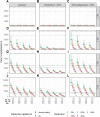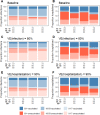Epidemiology and control of SARS-CoV-2 epidemics in partially vaccinated populations: a modeling study applied to France
- PMID: 35078469
- PMCID: PMC8789481
- DOI: 10.1186/s12916-022-02235-1
Epidemiology and control of SARS-CoV-2 epidemics in partially vaccinated populations: a modeling study applied to France
Abstract
Background: Vaccination is expected to change the epidemiology and management of SARS-CoV-2 epidemics.
Methods: We used an age-stratified compartmental model calibrated to French data to anticipate these changes and determine implications for the control of an autumn epidemic. We assumed vaccines reduce the risk of hospitalization, infection, and transmission if infected by 95%, 60%, and 50%, respectively.
Results: In our baseline scenario characterized by basic reproduction number R0=5 and a vaccine coverage of 70-80-90% among 12-17, 18-59, and ≥ 60 years old, important stress on healthcare is expected in the absence of measures. Unvaccinated adults ≥60 years old represent 3% of the population but 43% of hospitalizations. Given limited vaccine coverage, children aged 0-17 years old represent a third of infections and are responsible for almost half of transmissions. Unvaccinated individuals have a disproportionate contribution to transmission so that measures targeting them may help maximize epidemic control while minimizing costs for society compared to non-targeted approaches. Of all the interventions considered including repeated testing and non-pharmaceutical measures, vaccination of the unvaccinated is the most effective.
Conclusions: With the Delta variant, vaccinated individuals are well protected against hospitalization but remain at risk of infection and should therefore apply protective behaviors (e.g., mask-wearing). Targeting non-vaccinated individuals may maximize epidemic control while minimizing costs for society. Vaccinating children protects them from the deleterious effects of non-pharmaceutical measures. Control strategies should account for the changing SARS-CoV-2 epidemiology.
Keywords: Non-pharmaceutical interventions; SARS-CoV-2; Vaccination.
© 2022. The Author(s).
Conflict of interest statement
The authors declare that they have no competeing interests.
Figures




References
Publication types
MeSH terms
Substances
Supplementary concepts
LinkOut - more resources
Full Text Sources
Medical
Miscellaneous

